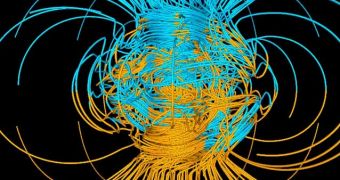It will be the world's strongest magnet for neutron experiments, eclipsing the 15-tesla system now in use.
The new, high-field magnet, which is based on the magnet lab's Series-Connected Hybrid concept, will be housed at the Berlin Neutron Scattering Center. The magnet will produce a magnetic field between 25 tesla and 30 tesla - more than half a million times stronger than the Earth's magnetic field, and will be finished in 2011.
The lab's Series-Connected Hybrid combines copper-coil "resistive" magnet technology in the magnet's interior with a superconducting magnet, cooled with liquid helium, on the exterior. The copper-coil insert is powered by an electrical current, while the superconducting outsert conducts electricity without resistance as long as it is kept colder than 450 degrees below zero Fahrenheit (-267.7 C) which is pretty close to absolute zero (-273.15 C or -460 F).
By combining the power supplies of these two technologies, engineers can produce extremely high magnetic fields using just one-third of the power required by traditional magnets.
The version that magnet lab engineers will build for HMI is different in that its bore, or experimental space, will be conical to allow neutrons to be scattered through large angles. It will also be horizontal, as opposed to the traditional vertical bore of most high-field magnets.
These modifications make the magnet ideal for neutron scattering experiments, which are among the best methods for probing atoms to better understand the structure of materials.
With this new magnet, scientists will be able to carry out experiments that aren't currently possible. One of the greatest challenges in condensed matter physics is to develop a comprehensive theory describing high-temperature superconductors.
The combination of neutrons and high magnetic fields will allow scientists to study the normal state of high-temperature superconductors in the low-temperature limit. In addition, it will be possible to probe hydrogen structure in both biological and hydrogen-storage materials.
"Part of the challenge in science is figuring out how to maximize resources," said Mark Bird, interim director of the Magnet Science & Technology division. "We can't always afford to bring the tools and techniques to the magnets; sometimes we have to bring the magnets to the tools to advance the science."
The Hahn-Meitner Institute itself will thus become a magnet, with this major piece of equipment, pulling in researchers from around the world to Berlin.

 14 DAY TRIAL //
14 DAY TRIAL //